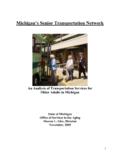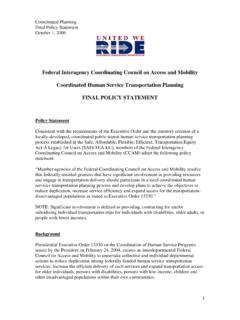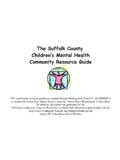Transcription of Transportation Options for People who are Blind …
1 3/9/20121 Transportation Options for People Transportation Options for People who are Blind or have Low VisionDennis P McCarthy, PhD, OTR/lAssistant Professor, Occupational Therapy DepartmentAssistant Professor, Occupational Therapy DepartmentDirector, South Florida Community Mobility Research LabResearch Associate, Lehman Center for Transportation ResearchThe importance of Transportation Transportation is essential for autonomy, dd hlh d l f lf 2independence, health, and quality of life (Dickerson, et al. 2007) Transportation provides us with the ability to engage in various activities (working, shopping, socializing) and fulfillment of roles Transportation enables us to engage in our favored activities and meaningfully connect favored activities and meaningfully connect our lives to our world (Gourley 2002)3/9/20122 Compensatory strategies for decreased community mobility = Transportation optionsWh t ti il bl f li t ?
2 3 What Options are available for our clients? Public Transportation Paratransit services Specialized Transportation Commercial and human service transportationtransportation Walking & other forms of Transportation Rides with othersTypes & Levels of service Type of services Fixed route4 Flexible route Demand-response Levels of service Curb-to-curb Door-to-door Doortodoor Door-through-door Escort services3/9/20123 Trips & trip chaining A trip Considered one-way travel5 Home to grocery store = 1 trip Home to grocery store, grocery store to home = 2 trips Home to grocery store to bank to home = 3 trips Trip chaining Any travel involving 3 or more trips Ability to chain trips dependent on mode of travelyppPublic Transportation Typically includes buses, but may also include rail, shuttles, etc6etc Fixed route, set schedule, curb-to-curb service Low cost Often present in urban and suburban areas.
3 Rare in rural areas 65% have limited or no access (Freeman 2006)3/9/20124 Functional abilities required for public Transportation use Physical function Public trans ortation has a walking com onent at each 7 Public Transportation has a walking component at each end of the trip Waiting at the bus stop Climbing steps Cognitive abilities Route planning, transfers Vi i Vision Reading bus schedules, recognizing stops Psychosocial Interactions with operator, other passengers Dealing with unexpected situationsBarriers to public transit use Real.
4 Sidewalks, walking d b /hl 8distance, bus stops/shelters, features of the vehicle, limited destinations Perceived: dirty, unsafe, untimely, confusing, unreliable, costly Personal: decreased vision, cognition, physical functioning, lack of confidence3/9/20125 Barriers to the use of public Transportation to People who are visually impaired Route timetable fare and customer service brochures 9 Route, timetable, fare, and customer service brochures that are available only in print format Maps, print or graphic information on signs Bus stop locations.
5 Before or beyond the corner, mid-block Ticket vending machines ADA requires removal of barriers to those with visual impairment Providing large-print, high-contrast, and non-glare informational signs Pl i b ill d t til i fti di il bl 10 Placing braille and tactile information regarding available service at consistent locations Installing a tactile domed high-contrast warning surface along platform edges. Making stop announcements inside transit vehicles at main points along the route. Providing external speakers that announce vehicle identification information.
6 Providing ticket vending machines with braille and large-print markings, or audible output devices. Training transit personnel to meet the specific needs of persons with visual impairments3/9/20126 Promoting public Transportation use Travel training Originated in New York (~1970) (Wolf-Branigin 2009)11 Provides one-on-one, individualized travel instruction in travel skills Includes the trainer riding with the client while using the system Increase user confidence and ability Travel trainers typically work in the community and are employed by non-profits, for-profits, Transportation agencies, employed by nonprofits, forprofits, Transportation agencies, and schools Travel trainers may be available through pubic Transportation agencies, local aging/human service organizationsAssociation of Travel Instruction.
7 Public Transportation use Locus of control: Independence (versus depending on 12family and friends) User-friendly services Ergonomic vehicles Operator sensitivity Bus buddies Technology gy3/9/20127 Special Transportation Services (STS) Americans with Disabilities Act (ADA) requires paratransit services be provided for People who cannot use public 13transportation Eligibility requirements Depends on an individual s inability to use fixed-route services versus the presence of a disability Proximity to fixed route system Typically use vans and/or w/c accessible buses for non-medical emergency tripsgyp Shared rides Flexible route, door-to-door serviceMDC STS Service to/from destinations mile from fixed route service Uses privately contracted sedans and vans some equipped with 14and vans.
8 Some equipped with w/c lifts Service available 24/7 Reservations made 24 hours in advance No trip restriction $3/one-way trip1 5 illi id i 200910 million rides in 2009-10 2011 Budget: $37 M 2011 Revenue: $ 4 MPhotos: ; to enhance accessibility for People with visual impairments Computer screen interfaces reads aloud information d d 15presented in video monitors Ticket machines that include speech output Information kiosks with tactile maps that can talk about places of interest and destinations Route planning software available on transit Websites GPS technology monitors location.
9 Triggers stop announcements Infrared and radio transmitters broadcast virtual messages that can be heard by voice output receiversSpecialized Transportation Hospital-based transportationB hl16 Business shuttles Senior center buses Adult day services Retirement community shuttles3/9/20129 Commercial Transportation Ta x i s Most similar mode of Transportation to th i t 17the private car Where you want to go, when you want to go there Real and perceived barriers to usage: Wait times, reliability, punctuality, driver issues, unfamiliarity, not knowing services exist, cost, maintenance of vehicles, vehicle design assistance with packages mobility design, assistance with packages, mobility devices Facilitators.
10 High satisfaction rate (Kostyniuk 2003), flexibility, assistance with packages, mobility devicesRides from others Most common mode of Transportation after driving (Davey 2007) Family18 Spouse, daughters, daughter-in-laws (Taylor and Tripodes 2001) Friends Paid & Volunteer driver programs (Supplemental Transportation Programs (STPs)) Commonly operated by faith-based and non-profit organizations Various models of volunteer driver programsVarious models of volunteer driver programs Volunteer service organizations Red Cross, American Cancer Society3/9/201210 Walking & other Walking Two walking trips are required for each transit trip19 Requires physical ability and stamina Most walking occurs in urban areas where sidewalks are available and destinations are close together Risk of injury/death greater than as a driver Bicycling Golf carts Golf cartsPedestrians203/9/201211 Connecting clients with Transportation Considerations for Transportation Options Eligibility21 Affordability Accessibility Mobility managers Guide clients through Transportation








